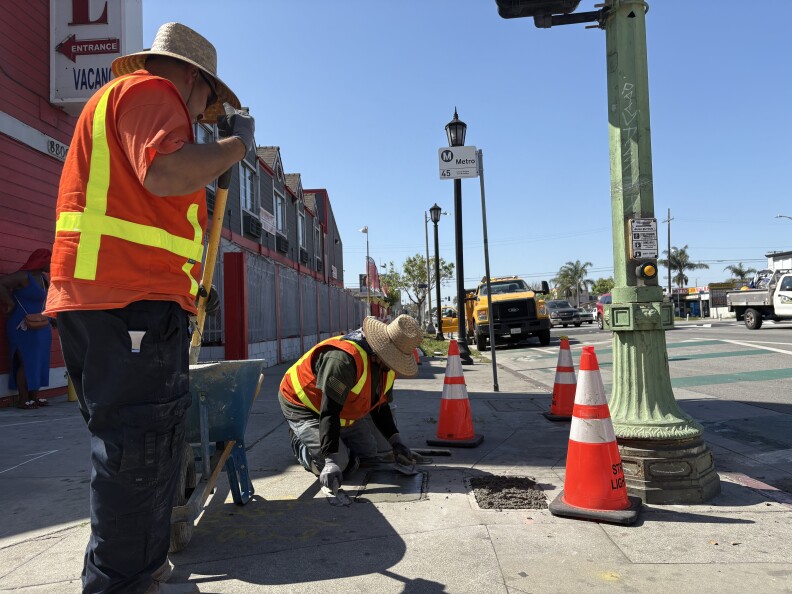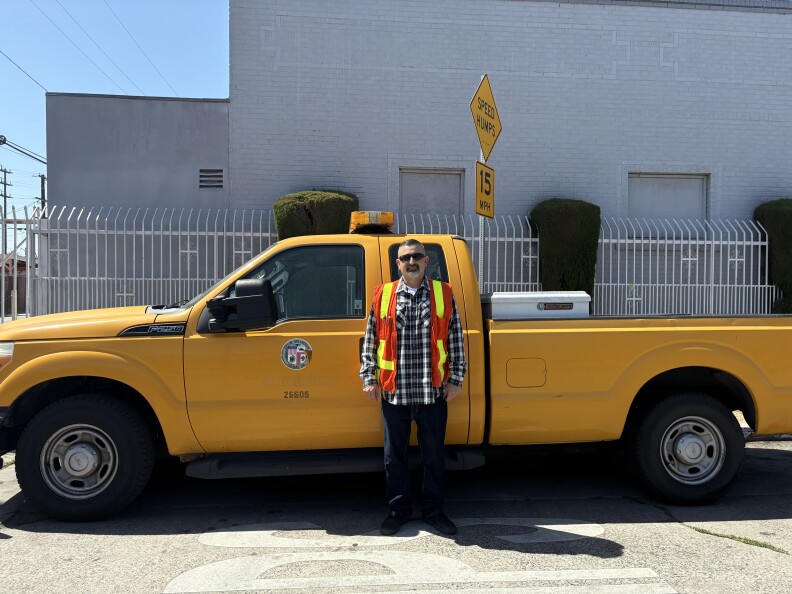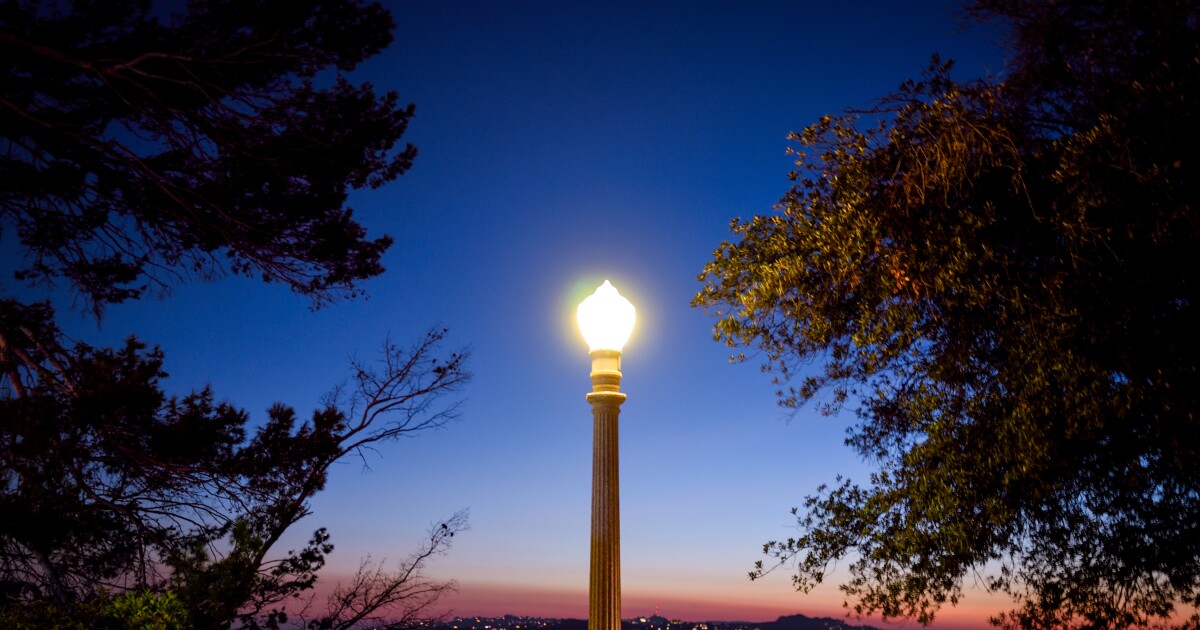Keep up with LAist.
If you’re enjoying this article, you’ll love our daily newsletter, The LA Report. Each weekday, catch up on the 5 most pressing stories to start your morning in 3 minutes or less.
Half a million property owners in L.A. could participate in an unconventional vote this fall that would determine the fate of the city’s street lighting infrastructure.
The ballots, if necessary steps are first taken by the City Council, will ask property owners whether they’d pay more in fees to increase the city’s street light budget, which has largely remained stagnant for three decades because of state law.
Miguel Sangalang, the executive director of the city’s Bureau of Street Lighting, said that an increase in revenue could dramatically reduce the wait time for street light repairs, replace aging infrastructure and provide the funding and staffing he said the bureau needs to fortify infrastructure against relentless copper wire theft.
“We’re trying to right-size operations to match the needs today,” Sangalang told LAist. “We have this 100-year-old infrastructure that we need to start replacing. We’re facing new theft and vandalism.”
Why is the street light budget frozen?
Approximately 90% of the city’s Bureau of Street Lighting budget comes from an assessment that people who own property illuminated by lights pay on their county property tax bill.
The exact assessment per parcel depends on whether it’s commercial or residential and how much the property benefits from street lighting, among other factors.
The average annual assessment throughout the city is about $80, according to a third-party analysis of the bureau’s revenue. Owners of most single-family homes pay around $53 per year, Sangalang told local officials in April.
The rates have been the same ever since California voters approved Proposition 218 in 1996. The initiative limits how much cities and towns can increase local revenue, including from “special benefits” like street lighting.
The city can’t approve a higher assessment for streetlight repairs without approval from property owners.
L.A. City Councilmember Eunisses Hernandez said a fee increase has been a long time coming.
“There’s been no reason why these fees haven’t been updated to meet current standards,” Hernandez said. “It’s just that there hasn’t been the political will to do that.”
The city hired Matrix Consulting in 2024 to analyze the revenue the Bureau of Street Lighting needs to maintain its network.
The third-party study found that the assessments the bureau currently collects equate to 45% of what it needs to “properly maintain and operate the system,” according to a summary of the report from the City Administrative Officer.
The consulting group determined that “property assessments need to increase at an average of 123%” to meet the needs of the bureau in the 2025 to 2026 fiscal year, according to the summary.
“The funding level recommended by Matrix will allow the [Bureau of Street Lighting] to reduce service response times to two days, allow for preventative maintenance to further the lifespan of lighting assets and [establish] a pole replacement program,” the summary said.
What’s the timeline for the vote, and how would it work?
Before ballots are sent out, the L.A. City Council has to approve what’s called an engineer’s report, which will quantify the proposed assessment increases for each parcel and show how the extra revenue will help the Bureau of Street Lighting meet the cost of maintaining service and implementing improvements.
Sanglang said he hopes to present the necessary paperwork before local leaders this summer and have ballots sent out in the fall.
“ We’re hoping to share all the information that we have to try and convince the voters to vote in the way that would help the street lighting network,” Sangalang said.
One of the unique aspects of this process is that the power of one vote might not equal the power of another. The ballots will be weighted “according to proportional financial obligation,” a spokesperson for the Bureau of Street Lighting said in a statement.

The city of L.A.’s Bureau of Street Lighting has a staff of about 180 people responsible for maintaining a network of nearly a quarter million street lights scattered across 470 square miles.
“A majority approval exists if weighted ballots submitted in favor exceed weighted ballots submitted in opposition to the assessment,” according to the spokesperson. “If a majority of the weighted votes do not oppose the assessments, the agency may vote to levy the assessment.”
If the timeline holds and property owners approve, the increased assessments could be effective as soon as the start of 2026.
Sanglang said the vote could mean the difference between a two-day turnaround time to fix a broken streetlight and the year-long timeline he said is currently projected if the assessment isn’t increased.
Hernandez acknowledged that convincing property owners to pay more for street lighting could be difficult, especially considering the city recently increased sanitation fees.
“It might feel like we’re just piling on these fees, but also this work should have been getting done,” Hernandez said. “ My colleagues, in the current configuration we’re in — we’re doing a lot of cleanup of the dereliction of duty from the past.”
Property owners, let us know what you think
-
If the vote moves forward in the fall, how would you vote? Do the street lights on your property work? If they’ve broken in the past, were they fixed quickly? If you have any thoughts, I’d love to hear from you. My email is kharjai@scpr.org or you can reach me on Signal. My username there is kharjai.61. You can follow this link to reach me there or type my username in the search bar after starting a new chat.
Santa Clarita attempted a similar process to increase street lighting fees in 2018. Ballots there were never tabulated after residents complained of poor communication from the city, which terminated proceedings soon after, according to a review of City Council meetings at the time.
As a result, more than 35,600 property owners in Santa Clarita pay, and have paid for the last three decades, just above $12.30 annually for street light maintenance, according to Andrew Adams, the city’s special districts manager.
Forty thousand properties in the city in a different streetlight maintenance district pay a higher rate of $66 that increases with inflation, Adams said.
The city of L.A. also has different streetlight maintenance districts. Unlike in the city of Santa Clarita, where more than half of property owners in the streetlight maintenance district essentially subsidize upkeep for others, 98% of property owners in Los Angeles pay assessments that have been frozen since Proposition 218.

Miguel Sangalang, the director of the Bureau of Street Lighting, talks about the pilot program under one of the new solar streetlights in front of the Children’s Community School with Mayor Karen Bass, L.A. City Councilmember Imelda Padilla, and members of the Van Nuys community.
(
Makenna Sievertson
/
LAist
)
The state of street lighting in L.A.
Requests made through 311 for street light service have ballooned from 15,600 requests for service in 2016 to 46,000 requests last year, according to an LAist analysis of data.
Sangalang said the disrepair is partially attributed to an increase in copper wire theft.
It’s an epidemic that today causes 40% of all streetlight repairs, he said. He added that just two years ago, only a quarter of all service calls were because of theft.
Along a six-block stretch of Broadway in South L.A., crews from the Bureau of Street Lighting worked for four days in May to restore streetlights that have been out since 2023 because of copper wire theft.
“By the time we get to 2025 [requests], it’s probably gonna be … 2027,” Daniel Franco, the copper wire theft supervisor for the bureau, told an LAist reporter at the repair site. “We’re trying to catch up. Jobs keep popping up.”

Daniel Franco, the supervisor of the Bureau of Street Lighting’s copper wire theft team, said there’s a big backlog in street light repairs in the city of L.A.
The crew of about 12 workers first repaired and rewired the lights at the site, then filled the boxes where the wires are stored with rocks and concrete and welded wraps around poles.
The thefts divert attention from routine maintenance and add costs and extra labor, Franco said. The fortification steps make it more difficult for thieves to steal the wire and will also make it more difficult for future crews to perform routine maintenance on the same lights, he said.
Sangalang said the bureau has taken steps to become “an incredibly efficient machine,” including lowering power costs by using LED lighting and beginning to deploy solar-powered lights.
Indeed, since the last time LAist analyzed 311 data in March, the bureau closed an additional 5,560 requests for streetlight repairs made in 2024.
“Our issue is one of scale,” Sangalang said, adding that the bureau has a staff of about 180 people to maintain a network of 220,000 streetlights across 470 square miles.
The issues affecting the bureau, he said, will have “a snowball effect on the larger system.”
“Every machine needs to refuel at some point, and we’re at that point,” Sangalang said.
